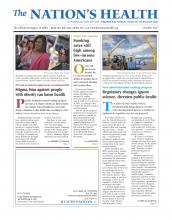Over the past several decades, the U.S. has seen marked declines in smoking, due in part to increased education and cessation efforts.
Even recent history shows significant improvements: Smoking rates among U.S. adults decreased from 20.9 percent in 2005 to 15.1 percent in 2015, according to the Centers for Disease Control and Prevention.
But for all the progress achieved, low-income people continue to smoke at disproportionately high rates compared with the general population. For Americans whose incomes fall below the federal poverty threshold, rates of smoking still hold at more than one-quarter of the group.
The tobacco industry has had a strong influence on low-income people and cultural norms surrounding smoking, targeting low-income communities with heavy marketing and engaging in other deceptive tactics to keep people hooked on tobacco. Meanwhile, many low-income people who smoke reside in communities in which public health efforts aimed at cessation have not made as much of an impact or effectively reached people who most need resources to quit.
“The efforts that have been made — messages that you should quit, cessation, smoke-free laws — those have not been equally available or equally applied across society,” APHA member Bill Blatt, MPH, national director for tobacco programs at the American Lung Association, told The Nation’s Health.
The leading cause of preventable death and disease in the country, according to CDC, smoking harms both the people who use tobacco products as well as their communities. Smoking has been linked to a range of health problems affecting nearly all organs, such as lung cancer, heart disease and colon cancer. People exposed to secondhand smoke are also at increased risk for smoking-related illnesses.
The ubiquity of tobacco in low-income populations reflects numerous social determinants of health: Education, culture and community are all factors that affect people’s ability to cut out tobacco. As such, it requires a combination of approaches rooted in science and policy to help low-income tobacco users live smoke-free.
One such method in resisting tobacco’s influence in low-income communities is cracking down on tobacco retailing practices. According to Ilana Knopf, JD, director of the Public Health and Tobacco Policy Center at Northeastern University School of Law’s Public Health Advocacy Institute, the retail environment plays a role in purchasing behaviors and tobacco consumption.
“(The tobacco industry’s) strategy continues to focus on maintaining their customer base, which is consistently disproportionately low-income populations, which are confronted with other stressors in life” that make it more difficult to quit smoking, Knopf, an APHA member, told The Nation’s Health.
Reducing the density of tobacco retailers, particularly in urban environments, can lessen the influence of tobacco in people’s lives, especially the amount of harmful marketing that people are exposed to every day.
Another practice that has shown to be effective in stamping out tobacco is implementing smoke-free policies in housing and public spaces such as parks and common areas. In November, the Department of Housing and Urban Development announced a prohibition on smoking in public housing residences to take effect in 2017, with public housing authorities given a year and a half to put smoke-free policies into place. According to HUD, the rule will result in $94 million in savings in health care costs related to secondhand smoke.
People from low socio-economic backgrounds have a number of low- or no-cost options to help them quit smoking, some of which are provided through Medicaid-funded cessation coverage. There is also the CDC-run quitline, 1-800-QUIT-NOW, which connects people to free quit coaching, local referrals and other resources. The SmokeFree.gov website from the U.S. Department of Health and Human Services, National Institutes of Health and National Cancer Institute offers a range of tips and tools as well as specialized information for women, veterans, teens, Spanish-speakers and seniors seeking help with cessation.
But such resources do not help people who need them if they do not know that they can exist or how to access them. People who lack reliable transportation to get to health care appointments or internet access to utilize digital tools may fare worse than those with the financial means to stick to a comprehensive cessation plan.
“It’s a pretty complicated issue, but it’s really the overlay of biology with the environment that people live in and the availability of services,” APHA member Frank Leone, MD, MS, director of the Penn Stop Comprehensive Smoking Treatment Program at Penn Medicine, told The Nation’s Health.
That is why public health workers must consider all the factors that may be driving people to turn to — or continue — smoking. Lighting up a cigarette could be a coping mechanism for stressors related to poverty. Many low-income smokers also belong to other underserved populations with disproportionately high rates of smoking. According to CDC, about 1 out of every 4 lesbian, gay and bisexual adults smoke, as do almost one-quarter of adults with mental illness and people with a disability. Such groups already face worse health outcomes than the general population, which are compounded by tobacco use.
With so many challenges facing low-income smokers, it is imperative that public health understands their struggles and makes efforts to reach them, said Kristin Ashford, PhD, APRN, WHNP-BC, FAAN, director of the Perinatal Research and Wellness Center at the University of Kentucky College of Nursing. She noted that cessation may not be a top priority for some low-income smokers dealing with financial hardship.
But if public health workers can make an effort to make the first point of contact, people who smoke have a greater likelihood of successfully quitting. One intervention is to hire tobacco specialists to talk to patients in public health clinics about cessation strategies, whether they come in for prenatal care or a physical examination — a practice that should be standard in public health care settings, Ashford said.
Appropriate messaging is also critical in promoting cessation. Failure to separate people from their behavior only serves to further alienate them, according to Leone, who said he would like to see public health better communicate with smokers as opposed to chiding them. And shaming is not necessary when so many smokers already want to quit; they simply may not know how to go about it or face challenges to stop smoking, he said.
“This is one of the hardest things to quit, and most people have to try multiple times,” which is why it does not help to make smokers feel worse about their behavior, Blatt said.
Some public health campaigns have excelled at providing smokers with resources for cessation as opposed to merely telling them that smoking harms their health, said Erik Augustson, PhD, MPH, program director of the Tobacco Control Research Branch in the National Cancer Institute’s Division of Cancer Control and Population Sciences. He commended CDC’s Tips From Former Smokers campaign, which shows people living with tobacco-related diseases and disabilities and offers resources to quit, for its “motivational element.”
“Cognitive social psychology (says) that if you scare somebody about something but…don’t tell them what to do or offer them a way out, that’s a completely ineffective strategy,” Augustson told The Nation’s Health.
Helping smokers quit also depends on strong relationships between public health and the communities it serves. Public health workers who believe they can enter a low-income community, solve a deeply rooted problem and then leave are misguided in their efforts, according to Blatt. Instead, public health must reach out to target populations and collaborate on interventions that will be long-lasting.
“Work with them to design the intervention, design the campaign and then together, roll out the program,” he said. “Hopefully, in doing that you’re actually improving community capacity.”
For more information, visit www.smokefree.gov.
- Copyright The Nation’s Health, American Public Health Association












